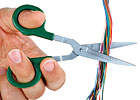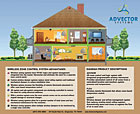Wireless Technology Breathes Life Into Mature Market

Wireless technology in HVAC can offer benefits similar to being able to control a marionette without strings: It opens up new opportunities. In the HVAC industry, it opens up market potential in a segment that was thought to be fully matured - and it couldn’t be happening at a better time. Here we look primarily at residential and light commercial markets.
Frost & Sullivan research on the North American HVAC thermostat market states that “Although traditionally considered a mature and highly concentrated market … the North American HVAC thermostat market continues to benefit from extensive technology development.
“This has led to high levels of competitiveness and imparted a certain dynamism not usually seen in older markets.
“Wireless thermostats are garnering increasing attention for their powerful features,” the report continued. “They allow end users complete freedom to locate and relocate thermostats in various rooms and spaces, without the inconvenience and hassle of running or diverting wires.”
“Wireless technology is probably the most significant leap the HVAC industry will make as far as adding value to the end customer, reducing installation costs, and dropping money to the bottom line for the dealer,” said Brad Paine, senior product marketing manager, programmable thermostats, Honeywell.
“The concept is simple in nature,” he said. “What used to take hours to install now takes minutes, and the value to the homeowner is equal or greater. For example, adding a wireless outdoor temperature sensor takes just minutes, but can add as much as $100 profit to any job. That may not seem like much, but the industry average profit on an equipment install is $400. Using wireless thermostats eliminates the need to run new wires on high-efficiency equipment sales. Again, reduction of labor equals profit for the dealer.
“From Honeywell’s perspective, the convergence of technology and market conditions has made the perfect storm for HVAC dealers to make a significant amount of profit by offering accessories,” he said. “In today’s market, every job counts and every dealer must maximize the profit opportunity of that job.”
RESIDENTIAL DRIVERS
Boris Medic, Advector systems managing partner and telecommunications engineer, who has experience working with global wireless infrastructure manufacturers like Nokia, offered his perspective on trends driving the emerging wireless market, specifically those related to residential HVAC zoning.He started with a little background. “Ten years ago, the cost of wireless was high and product development time was long,” he said. “There have been substantial changes in development tools, leading to more complete solutions. Also, consumers are looking for homes with more energy-efficiency features,” he said.
Now, “with the real estate bubble and glut of foreclosed homes, people are looking for more-efficient homes,” he said. Efficiency, in fact, can become a tipping point in their purchase decisions.
“There was a necessity to create products for energy control, primarily the HVAC systems,” Medic said. “In retrofit applications, it’s harder to do if it’s got wiring.” It becomes more labor intensive, he said, leading to higher costs and less flexibility of installation.
“On a retrofit install of a new system, the dealer’s costs are relatively fixed regardless of the efficiency of the equipment or the accessories offered on the equipment,” said Paine. “For example, a new install will take a full day (or two full days). This holds true if the installer is simply doing a changeout, or if the installer is doing a changeout, adding a humidifier, a new control, and wireless accessories.
“Therefore, dealers can utilize the fixed expense of deploying installers to a jobsite by making sure they have a full day, which is ultimately profitable for the dealer,” he said.
In new homes, on the other hand, wireless controls are used when homebuilders want to differentiate themselves from the foreclosed market, “for less than a third of the installation cost of a wired solution.”
Beyond the labor savings of wireless technology, users need to keep in mind that “An energy management solution isn’t just the thermostat; the airflow needs to be managed,” Medic said. A major factor in residential use is the ability to provide zoning. “It’s the entire management system that needs to control the air and be user friendly. It allows users to make changes on the fly, or give them remote access via a wireless application.”
“Too many dealers are focused on the equipment install, and they lose track of how large the accessory opportunity really is,” said Paine. “According to Honeywell’s research, a dealer can make as much or more bottom-line profit by upgrading the thermostat, adding wireless accessories, and installing an electronic air cleaner or humidifier. The additional labor is minimal and the profit falls directly to the bottom line, not to mention getting a happier, more comfortable customer.”

Wireless advantages (Courtesy of Advector Systems).
MID-SIZE CUSTOMERS
In the commercial market, “What is being heralded as a new class of drop-in energy management system (EMS) for small- to mid-size commercial buildings has arrived, made possible by the recent advances in wireless technologies,” said Davis Watkins, vice president of commercial sales for Advanced Telemetry. “Quite simply, an entire segment of commercial buildings that was previously unable to afford a sophisticated EMS now has some very compelling options.“What these affordable, feature-rich, wireless EMS products offer this untapped market segment is real energy savings that enhance profitability, and a reduced carbon footprint in line with increasing demand for companies to employ green business practices. What’s equally exciting about this technology is its operational simplicity and ease of use.”
Watkins said this has been a hard-to-address market, at least for EMS strategies. “Until now, most businesses that occupy a space in the 10,000-square-foot range have had no affordable option to implement a building management system of any notable scale,” he said. “And ironically, a large portion of this building-size segment uses more energy per square foot than any other commercial space.”
Buildings in this range include “the hundreds of thousands of quick-serve and fast, casual restaurants, convenience stores, banks, and retail spaces across the U.S.,” he explained. “As you might imagine, HVAC equipment … is the largest source of energy drain for these small- to mid-size businesses. For restaurants in particular, these systems can be responsible for fully 40 percent of their total energy bills.”
In these applications, wireless technology rectifies the situation by supporting multiple controls for that building’s main energy-using systems, HVAC and lighting. “The system also allows for real-time wireless monitoring of the total electrical consumption (kWh) for the entire building,” Watkins said. It also enables remote monitoring and control via the Internet.

The outdoor sensor wirelessly communicates the outdoor temperature and humidity levels to all RedLINK-enabled thermostats and the Portable Comfort Control (PCC). (Photo courtesy of Honeywell.)
A factory accessory allows wireless control of up to eight other circuits for lights, ventilation, or cooking equipment. Basically, any equipment that could benefit from having an operation schedule applied can usually be joined to the network.
“Next, simple current transformer clamps are slipped around the main electrical feed lines to the building,” said Watkins, “and they are joined to the network. A real-time graphic interface touch panel display is installed on the wall in a manager’s office.” This panel is the local central control and monitoring point for all HVACR equipment, lighting, and other mechanicals.
“Simply enable the power and Internet connection button on the back of the touch panel, and the building is now saving energy, saving money, and controllable remotely via the Web,” Watkins said.
With size reductions in radio frequency (RF) hardware and micro-controllers, “embedded modules that can function as a fully featured wireless node started being introduced to the market with the size of less than an inch,” said Medic. “Ten years ago it would be the size of a TV remote control.”
Is there anything that potentially interrupts wireless signals? According to Medic, that problem has been mitigated with wireless mesh networks. “Any devices in the same network - the damper, the wireless temperature sensor - has multiple links. If one fails, there are many others.” An industry standard “has been mainly designed for this spectrum of home automation,” he said. “Reliability and security were the main priorities.”

The EcoView Commercial wireless touch-panel from Advanced Telemetry.
CONTRACTOR READINESS
Although contractors have a reputation for being slow to offer such new ancillary products to customers, they may start responding to the changing demands of today’s consumers, who are now expressing greater interest in how products look, and how they are installed.“Contractors who aren’t aware are missing out on this new consumer,” Medic said. “If he doesn’t have those solutions, he’s losing credibility,” as well as potential sales.
Consumers have embraced wireless in every aspect of their lives, he said. “Every other industry has rapidly grown in implementing those new technologies. I don’t think there’s a single home in my neighborhood not affected by wireless.”
“As an HVAC contractor, it is certainly not news that the current business environment is tough,” said Watkins. “But even when business is booming, competition from new players in your market, amid an industry that rarely grows over 4 percent each year, makes it difficult for even the best-in-class HVAC contractors to survive, let alone thrive.”

Honeywell’s RedLINK wireless technology, the Prestige high-definition thermostat connects wirelessly to the Portable Comfort Control and remote outdoor temperature and humidity sensor. (Photo courtesy of Honeywell.)
“This new class of wireless drop-in energy management system will typically provide business owners with a payback on installed cost (ROI) in less than one year,” he said. “After that, all electrical savings transfers directly to the bottom line profits of that business.”
“At the end of the day, each dealer is running a business and maximizing each and every job opportunity; this is essential,” said Paine. “By offering the right mix of accessories and meeting the needs of the homeowners with those accessories, dealers can become exceptionally more profitable. They don’t have to take on more jobs, hire additional employees, or dramatically change their business model to make a major change in their business profitability.”
With customers in all market segments eager to control their energy costs, “wireless EMS offers unprecedented opportunity,” Watkins said. HVAC contractors are positioned to capitalize on this opportunity, “since you already have the relationships with this segment.”
For more information, visit www.advancedtelemetry.com, www.advectorsystems.com, www.frost.com, and www.honeywell.com.
Sidebar: Energy Harvesting Technology
BOSTON - EnOcean and Texas Instruments (TI) recently announced the expansion of their cooperation to provide innovative wireless solutions for building automation. The companies will jointly create solutions enabling self-powered wireless sensor networks. EnOcean said it will integrate TI components in its energy-efficient wireless modules.EnOcean’s battery-less wireless technology harvests energy from its surroundings - motion, light, or differences in temperature - and this enables the new, self-powered wireless applications.
“In Texas Instruments we have a strong partner, optimally supporting our innovative and self-powered wireless solutions with its ultra-low-power components,” said EnOcean’s CEO Markus Brehler. “Together we can effectively develop market-driven energy-harvesting wireless module solutions, which are an ideal basis for automation systems in sustainable buildings.”
“Energy-harvesting wireless technology reduces the installation cost of lighting, heating-air conditioning control, and monitoring by up to 70 percent. This technology enables long-term energy conservation and sustainability for our customers,” said Laurent Giai-Miniet, general manager of TI’s Low-Power RF business unit.
For more information, visit www.enocean.com.
Publication date: 08/09/2010



